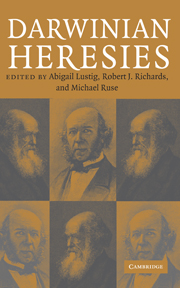Book contents
- Frontmatter
- Contents
- List of Contributors
- 1 Introduction: Biologists on Crusade
- 2 Russian Theoretical Biology between Heresy and Orthodoxy: Georgii Shaposhnikov and His Experiments on Plant Lice
- 3 The Specter of Darwinism: The Popular Image of Darwinism in Early Twentieth-Century Britain
- 4 Natural Atheology
- 5 Ironic Heresy: How Young-Earth Creationists Came to Embrace Rapid Microevolution by Means of Natural Selection
- 6 If This Be Heresy: Haeckel's Conversion to Darwinism
- 7 Adaptive Landscapes and Dynamic Equilibrium: The Spencerian Contribution to Twentieth-Century American Evolutionary Biology
- 8 “The Ninth Mortal Sin”: The Lamarckism of W. M. Wheeler
- 9 Contemporary Darwinism and Religion
- Index
6 - If This Be Heresy: Haeckel's Conversion to Darwinism
Published online by Cambridge University Press: 11 July 2009
- Frontmatter
- Contents
- List of Contributors
- 1 Introduction: Biologists on Crusade
- 2 Russian Theoretical Biology between Heresy and Orthodoxy: Georgii Shaposhnikov and His Experiments on Plant Lice
- 3 The Specter of Darwinism: The Popular Image of Darwinism in Early Twentieth-Century Britain
- 4 Natural Atheology
- 5 Ironic Heresy: How Young-Earth Creationists Came to Embrace Rapid Microevolution by Means of Natural Selection
- 6 If This Be Heresy: Haeckel's Conversion to Darwinism
- 7 Adaptive Landscapes and Dynamic Equilibrium: The Spencerian Contribution to Twentieth-Century American Evolutionary Biology
- 8 “The Ninth Mortal Sin”: The Lamarckism of W. M. Wheeler
- 9 Contemporary Darwinism and Religion
- Index
Summary
Just before Ernst Haeckel's death in 1919, historians began piling on the faggots for a splendid auto-da-fé. Though more people prior to the Great War learned of Darwin's theory through his efforts than through any other source, including Darwin himself, Haeckel has been accused of not preaching orthodox Darwinian doctrine. In 1916, E. S. Russell judged Haeckel's principal theoretical work, Generelle Morphologie der Organismen, as “representative not so much of Darwinian as of pre-Darwinian thought.” Both Stephen Jay Gould and Peter Bowler endorse this evaluation, seeing as an index of Haeckel's heterodox deviation his use of the biogenetic law that ontogeny recapitulates phylogeny. Michael Ruse, without much analysis, simply proclaims that “Haeckel and friends were not true Darwinians.” These historians locate the problem in Haeckel's inclinations toward Naturphilosophie and in his adoption of the kind of Romantic attitudes characterizing the earlier biology of Goethe. These charges of heresy assume, of course, that Darwin's own theory harbors no taint of Romanticism and that it consequently remains innocent of the doctrine of recapitulation. I think both assumptions quite mistaken, and have so argued. But against the charge of heresy, one can bring a more direct and authoritative voice – Darwin himself.
In 1863, Haeckel made bold to send Darwin his recently published two-volume monograph on radiolarians – one-celled aquatic animals that secrete a skeleton of silica. The first volume examined in minute detail the biology of these creatures and argued that Darwin's theory made their relationships comprehensible.
- Type
- Chapter
- Information
- Darwinian Heresies , pp. 101 - 130Publisher: Cambridge University PressPrint publication year: 2004
- 5
- Cited by



